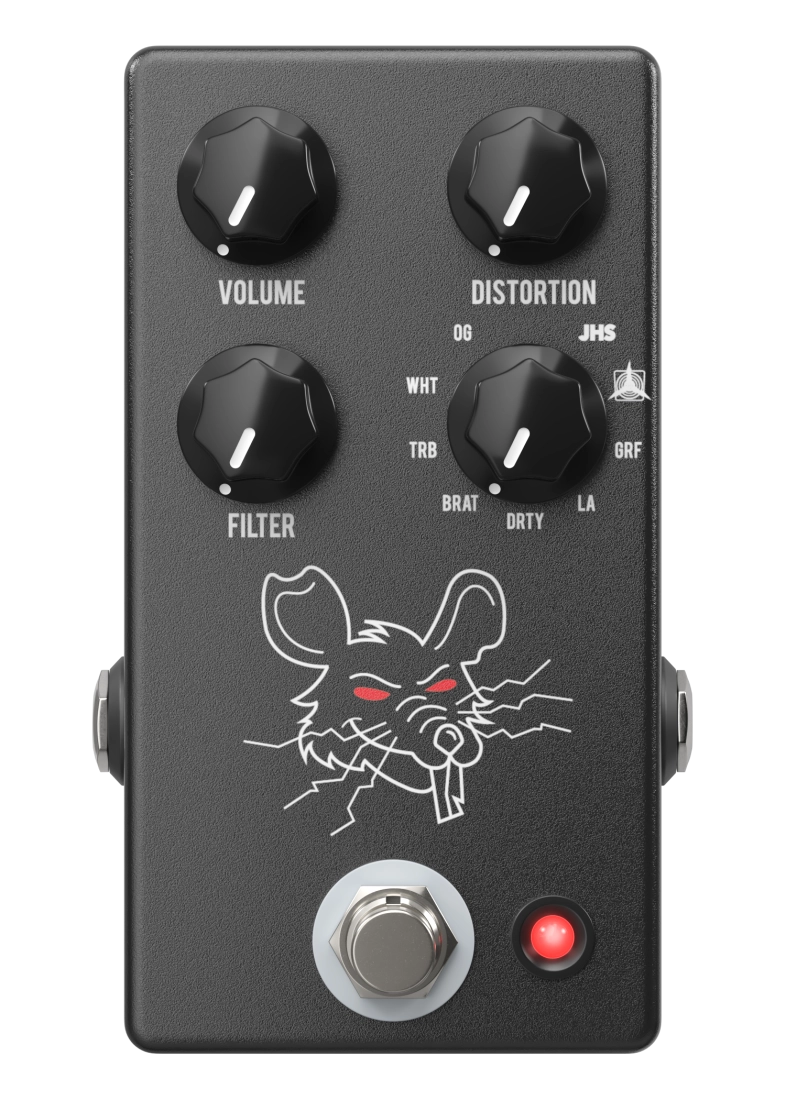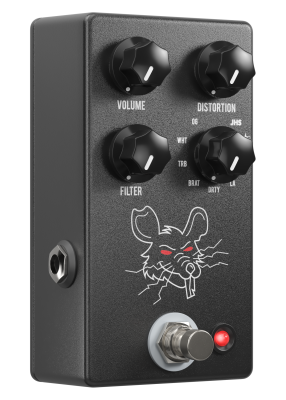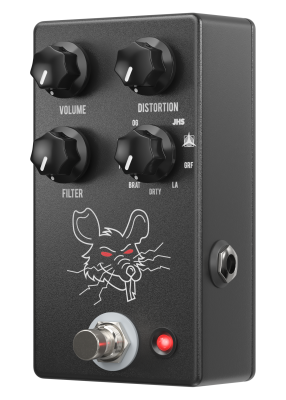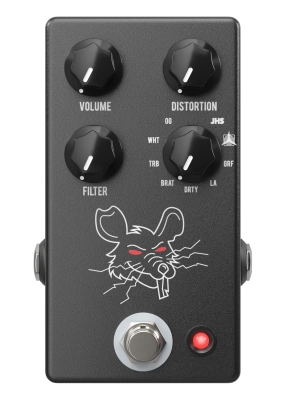JHS Pedals Packrat Fuzz Pedal

Additional Photos:


Building on JHS' Multi-Mode pedal series that includes the Muffuletta and Bonsai, the PackRat uses the same unique digital runway system to direct the paths of 261 components through 40 individual switches. This means that when you choose one of the nine legendary or rare modes, you are playing fully analog circuits that perfectly replicate that mode, even down to the aging components (also known as component drift).
Controls
The operation of the PackRat is about as simple as it gets. The "Volume" control adjusts the overall volume of the pedal. The "Distortion" control lets you raise and lower the amount of gain or distortion that the circuit produces, and the "Filter" control allows you to brighten and darken the sound of the overall effect. This is effectively a simple, low-pass filter. Lastly, "Mode" control. This is a stepped pot that clicks into place as you scroll through the nine legendary versions of this circuit. As you change the mode, the analog circuitry is rewired, resulting in brand new values of resistors, capacitors, diodes and op amps.
The PackRatModes
1. The OG (1979-83)
The OG mode is a perfect recreation of the first production RATs ever made. This era of roughly four years covers what is referred to historically as the V1 and V2 models.
When switching to the OG mode, you are activating the exact circuitry of a 1979 V1 model, including the accurate "Tone" control rotation and taper. The V1 and V2 models are the exact same circuit, and simple adjustments to the "Tone/Filter" control can achieve identical sounds from each unit.
2. White Face V3 (1984-1986)
The "White Face" model gained a reputation as one of the holy grail RATs, and it even spawned a reissue in the nineties. The irony is that it is the same exact circuit as the previous "Big Box" V2 and the following "non-white logo" 1986 V4, as well as the 1988 V5 "LED Version." The "White Face" V3 update was purely cosmetic (some V2s and V3s share the exact same circuit board). ProCo knew that the world wanted smaller pedals in the wake of brands like BOSS, DOD and Ibanez gaining more and more market share, and they wisely cashed in on the trend.
3. Turbo V6 (1989)
The heart of the RAT's tone comes from a design technique called "Symmetrical Hard Clipping." In this approach, a simple amplifier circuit amplifies the guitar's signal and pushes it across a pair of clipping diodes. The result is that these diodes clip off the top of the waveform of the guitar and create a type of square wave distortion. Every RAT until 1989 utilized a typical silicon diode, just like the DOD 250 and BOSS DS-1, but the new Turbo RAT used LEDs (Light Emitting Diodes).
The Turbo's LEDs have a much higher forward voltage, so they don't activate or clip the signal as fast or as hard. It takes more signal to reach the point where they will "cut off" the waveform, which causes the phenomenon known as "Touch Sensitivity." You can set the Distortion lower, and as you play lightly, you will have an overdrive tone; dig into your guitar and play hard, and hear more clipping/distortion.
4. BRAT (1997)
The BRAT added an input buffer circuit and soft clipping (inside the loop of the op amp) on top of the standard hard clipping of the previous RATs. A return to the opposite taper/rotation "Filter" control and several capacitor value changes that alter the frequency response and characteristics of the distortion.
5. Dirty (2004)
This pedal allowed you to have two completely separate RATs and activate them independently or stack them together. It also introduced two brand new sounds into the RAT topology: "Clean RAT" mode and "Dirty RAT." Due to the popularity of the "Dirty RAT" mode, they released a single pedal called "You Dirty RAT" that featured that single setting in a standard sloped RAT enclosure. This circuit utilizes germanium diodes in the symmetrical hard clipping section of the circuit. This technique gives the most saturation and waveform clip-off of any version ever made.
In addition to the diode changes, this model has several different capacitor value changes resulting in a different distortion character and feel.
6. LA (1986)
In 1986, Ibanez released the "10 Series" line of pedals that included three RAT style pedals. The "Super Product" and "Fat Cat" held the position of accurate and traditional RAT style pedals, while the quirkier "LA Metal" was one of the best-modified RAT circuits of the eighties. It includes a great input buffer, several key capacitor changes for frequency response, and no clipping diodes at all. The distortion is produced by overloading or "clipping the rails" of the op amp.
7. Landgraff MO'D (1999)
Between 1999-2000, a man named John Landgraff started building pedals by hand in Pensacola, FL. Each one painted with a unique swirl paint job and wired point to point; John's pedals were and still are the true definition of boutique and gained a reputation for sounding amazing. His most popular pedal was the Landgraff Dynamic Overdrive, a take on the Ibanez Tubescreamer.
8. Caroline (2010)
Based on work in conjunction with Philippe Herndon, this mode was inspired by the Wave Cannon pedal that started the PackRat project.
9. JHS Mode
Starting as a modded vintage "small-box" RAT, parts of that modification became the now discontinued JHS All American and the long-running JHS PackRat modification that was performed on thousands of RAT pedals from 2008-2018. The JHS Mode lets you keep what makes the RAT unique and adds in a few personalized mods.
Q & A
Reviews

Protect your investment with the Long & McQuade Performance Warranty
A warranty can be a very important factor when making a buying decision. Because repairs can be very expensive in terms of parts and labour costs, manufacturers usually only provide one year limited warranties that generally only cover items that malfunction due to a manufacturer’s defect. With an important purchase such as a musical
instrument or piece of studio gear, however, many people want to have the peace of mind in knowing that their investment will be protected should the product no longer be performing at 100%.
Because of this, Long & McQuade provides our customers with a FREE one-year Performance Warranty on most of our products. The Long & McQuade Performance Warranty supplements the manufacturer’s warranty to ensure that our customers receive complete “no hassle” warranty coverage within their first year.
How does the Long & McQuade Performance Warranty differ from most manufacturers' warranties?
- Performance Guarantee: Normal wear and tear is covered, so your product will be performing as well as the day you purchased it for the entire duration of the coverage. Band and Orchestral Performance Warranty does not include replacing pads or cleaning for woodwind instruments, unless deemed necessary by our repair staff. Ultrasonic cleaning for brass instruments will be provided if deemed necessary by our repair staff, but is not routinely offered under the Performance Warranty.
- Product Replacement: If your product cannot be fixed or costs too much to fix, we will replace it with the equivalent model for no additional charge. If this is not possible, a full refund will be provided.
- No Lemon Policy: Your product will be replaced should the same problem occur multiple times.
- Convenient: Easy drop off and pick up of the product at any Long & McQuade location.
- Guitar Setup: Guitars purchased at Long & McQuade come with 1 free setup, to be redeemed within 1 year for new guitars and 90 days for used guitars.
- Loaners Available: A loaner product may be given while the product is being repaired.
- Power Surge Protection: Your product is covered even if damaged from a power surge.
- Accessory Coverage: Any peripheral devices or accessories that come with your product (i.e. foot pedal, case) are also covered.
- Commercial Use Coverage: Music and recording professionals who purchase gear for “heavy-use” commercial purposes will still be covered.
Long & McQuade reserves the right to restrict the purchase of additional years of Performance Warranty. Used products come with a 3-month Long & McQuade Performance Warranty. Some products (i.e. computers, software, cymbals and other items) are covered only by the manufacturer‘s warranty. Consumables (i.e. strings, reeds, drum sticks, batteries, tubes, cross faders) are excluded as they are designed to be replaced. Cosmetic Damage, Accidental Damage, or problems caused by Humidity or Temperature Issues are not covered. Speakers damaged by overpowering are generally not covered. Our coverage does not provide compensation for loss of use. As of June 2018 the Performance Warranty is no longer transferable. The warranty is only valid in Canada.
Purchasing additional years of coverage
Some manufacturers provide warranties for longer than 1 year; however, these are usually limited warranties that do not provide the same coverage as the Long & McQuade Performance Warranty. Customers interested in more complete and convenient (but not necessarily longer) coverage are still able to purchase additional years of the Performance Warranty.
If you are interested in receiving this coverage for longer than one year, you have the option of purchasing additional years of the Performance Warranty. The pricing is as follows:
- NEW products: Starting at 4% of the current new selling price to double the warranty from 1 year to 2 years. Starting at 4% for each additional year.
- USED products: Starting at 4% of the current new selling price to increase the warranty from 3 months to 1 year. Starting at 4% for each additional year.
- GUITARS: 4% of the current new selling price to double the warranty from 1 year to 2 years. 4% for each additional year. $45 maximum. An additional free setup is not included with additional purchased years of Performance Warranty.
- BAND and ORCHESTRAL instruments: 4% of the current new selling price to double the warranty from 1 year to 2 years. 4% for each additional year.






